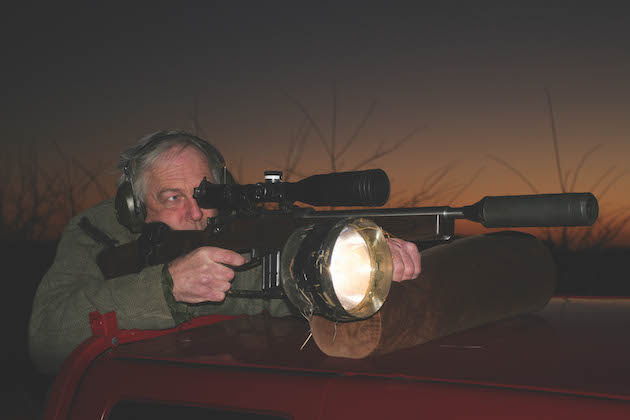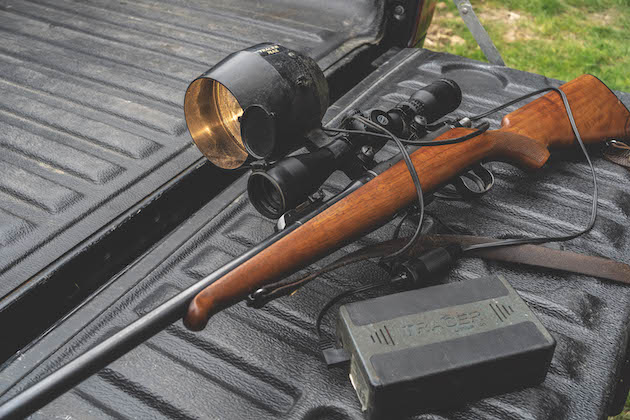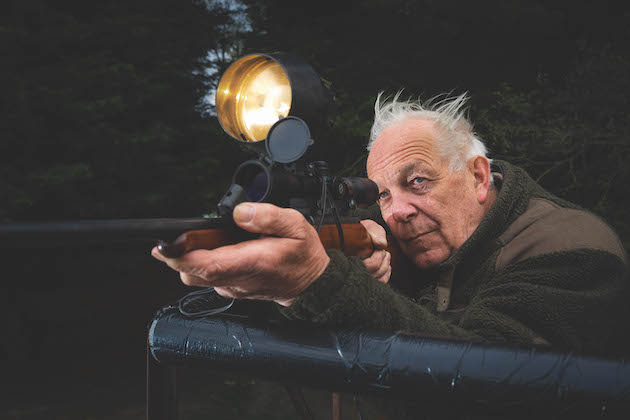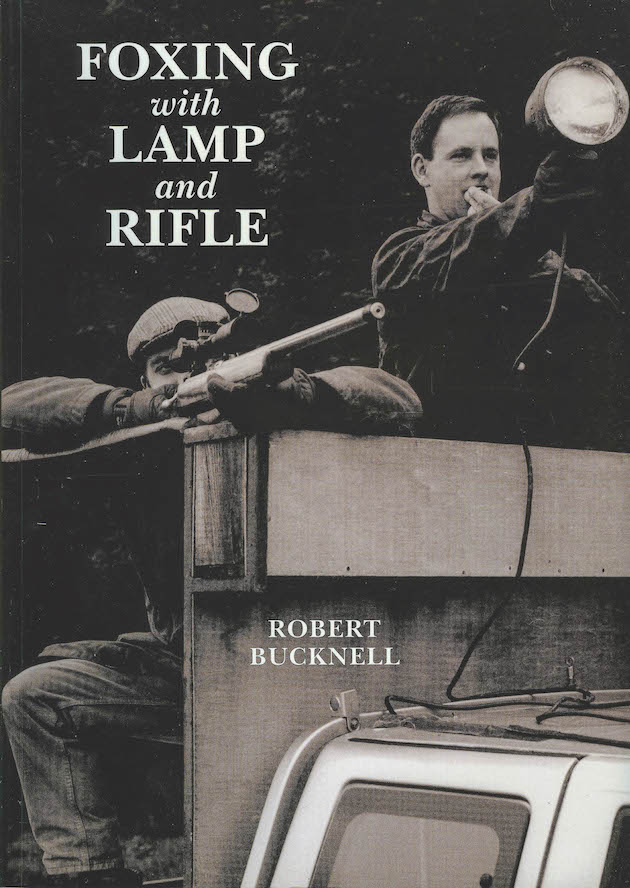Hunting lamps: we pick out the best around
The vast majority of us still rely on trusty hunting lamps to get the job done and ‘traditional’ lamping remains…
Win CENS ProFlex DX5 earplugs worth £1,149 – enter here

Fox shooting technology has come a long way since I first drove around a field in circles hoping to spot a fox in the headlights. That was in the early 1970s, and we thought we were at the cutting edge with our lamping kit when we bolted a wooden handle onto a chrome-plated Lucas Silver Sabre car spotlamp and set off on foot looking for foxes with a car battery in a rucksack. Splashes of battery acid played havoc with our jackets and gloves but it worked, and that’s what really mattered.

A snarling fox
We adopted new developments to our fox lamping kit eagerly as they came along, from ‘no spill’ gel batteries to xenon bulbs, red filters and eventually LEDs and lithium-ion batteries. Lamps became smaller and lighter and could even be fitted onto a scope or barrel. A whole industry grew up supplying specialist lamping kit to eager fox shooters.
There was much emphasis placed on the power of the lamp, measured in 100,000s of candlepower, and the distance at which you could spot your fox. We soon learned that all this power wasn’t necessarily a good thing, and careful use of a dimmer switch could put more foxes in the bag. I was never really convinced by the argument that foxes didn’t see red light, but the popular red filter did seem to help — perhaps because it dimmed the beam considerably, or maybe the light didn’t then look like car headlights, which many foxes had learned to avoid after a close call with a vehicle.
In recent years technology has transformed the art of foxing yet again, with the introduction of affordable, effective digital night vision and now the thermal spotters and riflescopes that so many keepers and pest controllers use today.
The great thing about thermal, of course, is that it’s entirely passive. Even digital night vision generally requires an infrared lamp, and some foxes see the IR light and shy away from it. Thermal, on the other hand, emits nothing; it simply views what thermal energy is out there and turns it into a picture. That means there is nothing to give you away to even the wariest fox — not from the device, anyway. It’s important to remember your fieldcraft — a whiff of human scent or the sound of metal on metal can send your quarry running for the hills.

From spotlamps and car batries to LEDs and lithium-ion, foxing equipment has come a long way
Having come all this way over the past half-century, you would think that there’s no place for the old-fashioned lamp — but there is. In fact, I still use one every time I go out in the truck patrolling around the farm for foxes, which is typically two or three times a week.
I have an excellent thermal viewer, a Pulsar Axion Key, which will spot a fox at several hundred yards, but I still find my spotlamp allows me to cover ground much more quickly and locate any fox that’s out and about. I can drive slowly along the farm tracks with the driver’s window open, swinging the beam back and forth looking for a glint of an eye.
The vast majority of us still rely on trusty hunting lamps to get the job done and ‘traditional’ lamping remains…
With nightvision shooting equipment becoming ever more popular, Ian Valentine asks the experts to weigh the latest green-tinted scopes against…
Lamping may be one of the most efficient ways to kill foxes but if you miss then, you’ll have created…
1. What’s the right time to go out lamping foxes? Foxes are generally nocturnal and see excellently at night. Wait…
I can sweep a good-sized field in seconds without even stopping, whereas to do the same thing with the thermal I would have to stop and scan the whole field in the Axion’s much narrower field of view. It works particularly well for me because here we have large, relatively flat fields where the lamp beam can reach a long way. For someone like my friend Mike Powell, who lives in the West Country, the fields are smaller and the terrain more uneven, so he tends to reach for the thermal first and only uses a lamp occasionally.
I use my lamp purely to locate a fox, and switch it off the moment I see a pair of eyes shining back at me. That shine, incidentally, comes from a reflective layer at the back of the fox’s eye, the tapetum lucidum. It’s what allows the fox to see so well in virtual darkness.

Robert uses his lamp purely to locate a fox, switching it off when he sees its eye-shine
Most foxes nowadays aren’t bothered by a lamp beam sweeping across them. They must encounter the same thing many times a night as a car takes a corner and its headlights swing across a field. What they don’t like, however, is being caught like the proverbial rabbit in the headlights. Perhaps they had a close encounter with a car when they were younger. I’m surprised how many of the foxes I shoot have signs of an old car-inflicted injury, such as a badly broken leg or a malformed jaw. Town foxes are particularly traffic aware; you’ll see them step out of the road onto the pavement, then stand and watch your car pass by.
The vast majority of us still rely on trusty hunting lamps to get the job done and ‘traditional’ lamping remains…
Fox control: Why do all the rifle experts have such a low opinion of the .22 rimfire for fox control?…
Lamping may be one of the most efficient ways to kill foxes but if you miss then, you’ll have created…
So I don’t let my lamp linger on any pair of eyes I see. I switch off immediately, stop the vehicle and move to the thermal. If the picture is good enough to identify the quarry positively, I can plan what to do next — perhaps calling, or if the fox seems set on heading in a particular direction, I might move to intercept.
Once I’ve flicked off the lamp I’m operating entirely with thermal; the only visual clue my quarry gets is the lamp sweeping past and disappearing. I’ll use the Axion to watch until I prepare to shoot, then switch to my thermal riflescope, a Pulsar Thermion XM50. It’s a system that works well for me and has accounted for around 200 foxes in the past two years.
That’s not to say you can’t still shoot foxes the old-fashioned way successfully, with a white lamp and a day scope, or another combination such as lamping and using a digital night-vision scope. You may call them in while spotting with a thermal to swap to white light for the shot. All those methods worked in the past and still work just as well today, it’s just that the modern, high-tech stuff works even better.
Not everyone wants to spend several thousand pounds on the latest thermal gear, and for anyone getting into fox shooting it’s a big investment before you are sure you’ll want to stick at it. You can start with just your day scope and a decent lamp. Fortunately, even a cheap, modern, handheld LED lamp will do the job, you don’t need to lug around a car battery and spotlamp like we did. You just have to remember — or perhaps relearn — all those skills we used in the days before night vision came along.
Fox shooting with a lamp is more of a team job, and made a fun night out with friends; that’s one thing I miss now that technology has made foxing more of a solo sport. Typically you’d have three of you: one to drive, another to operate the lamp and a third to do the shooting. The lamp man and the shooter would sit up on the back of the truck, ideally in a purpose-made shooting frame bolted firmly to the vehicle.
A good team soon learned to communicate efficiently. The lamp man would tell the driver to stop by knocking on the cab roof. The driver with his lower position often couldn’t see the fox, but he could see where the lamp was pointing. If the beam wiggled from side to side, he knew the fox had gone and it was time to drive on.
The lamp man becomes adept at keeping the main beam above the fox, rather than blasting it with the full one million candlepower. The edge of the beam is sufficient to keep the eyes lit up so the shooter can get ready. Then if he needs more light to be sure of the shot, he can whisper “down a bit”.
If the lamp has a dimmer switch, that can be used instead, while some old hands swear by coloured filters to reduce the chance of scaring off the quarry. The shooter needs to play his part, of course, taking a well-aimed shot without taking so long that the fox becomes nervous and runs off.

Robert Bucknall’s book is the ultimate guide to lamping foxes at night
Experience taught us that the three-man team was the most efficient way to lamp foxes, but it can be done with just two, or even solo if you have a rifle-mounted lamp. As with anything to do with foxes, an understanding of fox behaviour and good fieldcraft will improve your success rate no end.
If you get the bug, however, I’m willing to bet you will follow the path we did, adding night vision or thermal to your toolkit as soon as you can afford it. It may seem a bit clinical and lack the romance of the old ways, but you can’t beat it for sheer efficiency.
[/deal-block]
[/deal-block]
Get the latest news delivered direct to your door
Discover the ultimate companion for field sports enthusiasts with Shooting Times & Country Magazine, the UK’s leading weekly publication that has been at the forefront of shooting culture since 1882. Subscribers gain access to expert tips, comprehensive gear reviews, seasonal advice and a vibrant community of like-minded shooters.
Save on shop price when you subscribe with weekly issues featuring in-depth articles on gundog training, exclusive member offers and access to the digital back issue library. A Shooting Times & Country subscription is more than a magazine, don’t just read about the countryside; immerse yourself in its most authoritative and engaging publication.

